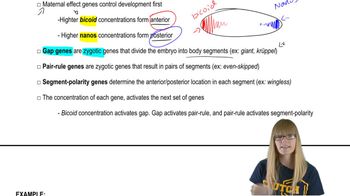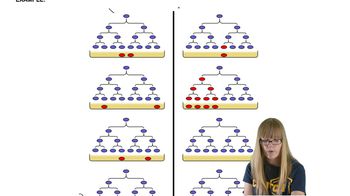How can proteomics identify differences between the number of protein-coding genes predicted for a genome and the number of proteins expressed by a genome?
Table of contents
- 1. Introduction to Genetics51m
- 2. Mendel's Laws of Inheritance3h 37m
- 3. Extensions to Mendelian Inheritance2h 41m
- 4. Genetic Mapping and Linkage2h 28m
- 5. Genetics of Bacteria and Viruses1h 21m
- 6. Chromosomal Variation1h 48m
- 7. DNA and Chromosome Structure56m
- 8. DNA Replication1h 10m
- 9. Mitosis and Meiosis1h 34m
- 10. Transcription1h 0m
- 11. Translation58m
- 12. Gene Regulation in Prokaryotes1h 19m
- 13. Gene Regulation in Eukaryotes44m
- 14. Genetic Control of Development44m
- 15. Genomes and Genomics1h 50m
- 16. Transposable Elements47m
- 17. Mutation, Repair, and Recombination1h 6m
- 18. Molecular Genetic Tools19m
- 19. Cancer Genetics29m
- 20. Quantitative Genetics1h 26m
- 21. Population Genetics50m
- 22. Evolutionary Genetics29m
15. Genomes and Genomics
Proteomics
Problem 13a
Textbook Question
The CBF genes of Arabidopsis are induced by exposure of the plants to low temperature. How would you examine the temporal and spatial patterns of expression after induction by low temperature?
 Verified step by step guidance
Verified step by step guidance1
Design an experiment to monitor the expression of CBF genes over time and in different tissues. This can be achieved by creating transgenic Arabidopsis plants with a reporter gene (e.g., GFP or GUS) fused to the promoter of the CBF genes.
Expose the transgenic plants to low-temperature conditions to induce the expression of the CBF genes. Ensure that the temperature and duration of exposure are consistent across all samples.
Collect tissue samples from different parts of the plant (e.g., leaves, stems, roots) at various time points after the low-temperature exposure. This will allow you to study both temporal (time-based) and spatial (location-based) expression patterns.
Analyze the reporter gene activity in the collected samples. For example, if using GFP, observe fluorescence under a fluorescence microscope. If using GUS, perform a histochemical staining assay to visualize expression patterns.
Quantify the expression levels of the CBF genes using molecular techniques such as quantitative PCR (qPCR) or RNA sequencing (RNA-seq) to validate and complement the reporter gene data. This will provide precise temporal and spatial expression profiles.
 Verified video answer for a similar problem:
Verified video answer for a similar problem:This video solution was recommended by our tutors as helpful for the problem above
Video duration:
2mPlay a video:
Was this helpful?
Key Concepts
Here are the essential concepts you must grasp in order to answer the question correctly.
Gene Expression
Gene expression refers to the process by which information from a gene is used to synthesize functional gene products, typically proteins. In the context of the CBF genes in Arabidopsis, understanding how these genes are activated in response to low temperatures is crucial for studying plant responses to environmental stress.
Recommended video:
Guided course

Penetrance and Expressivity
Temporal and Spatial Patterns
Temporal patterns of gene expression involve measuring how gene activity changes over time, while spatial patterns refer to where in the plant the gene is expressed. Analyzing these patterns helps researchers understand the dynamics of CBF gene activation and its role in cold acclimation in Arabidopsis.
Recommended video:
Guided course

Segmentation Genes
Induction Mechanisms
Induction mechanisms describe the processes that trigger the activation of specific genes in response to environmental stimuli, such as low temperature. Investigating these mechanisms can reveal the signaling pathways involved in the cold response and how plants adapt to changing climates.
Recommended video:
Guided course

Spontaneous Mutations
Related Videos
Related Practice
Textbook Question
345
views


